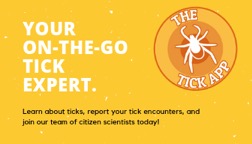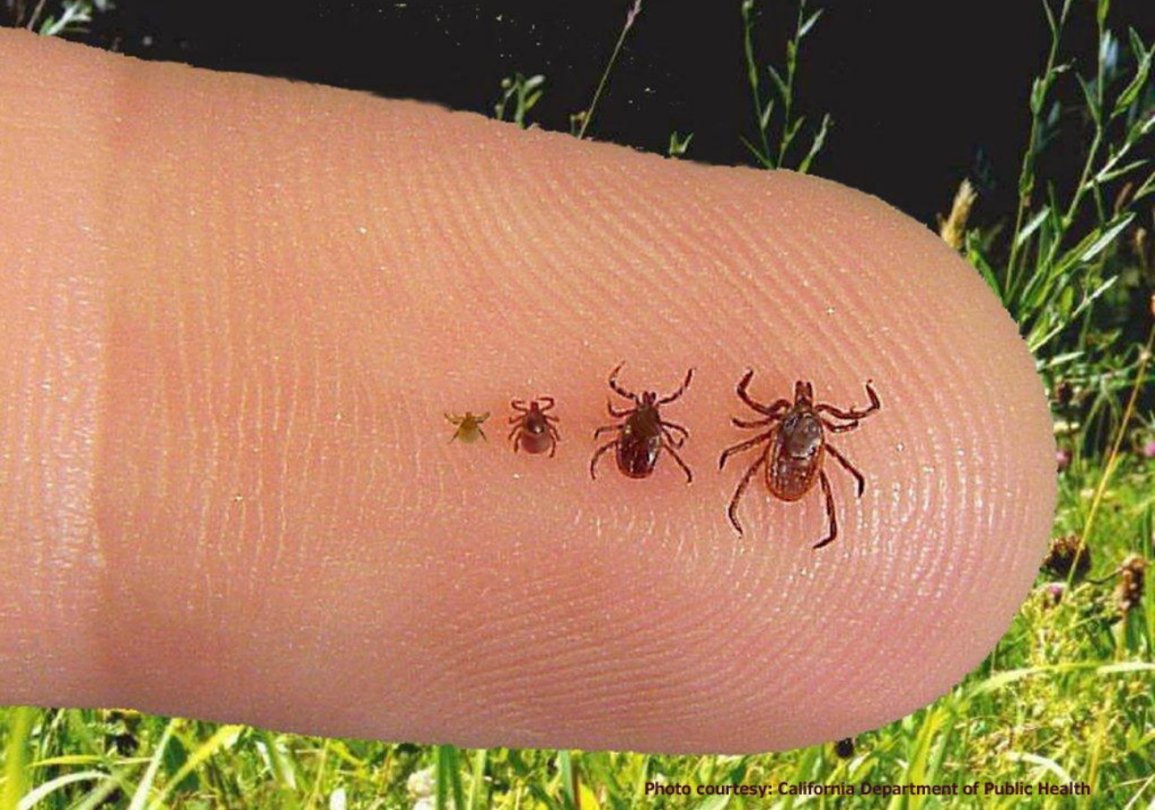Hello, Birders! Last year, in the spring of 2019, I received a fellowship from the Midwest Center of Excellence for Vector-Borne Diseases to work and gain experience under the mentorship of Dr. Jean Tsao at Michigan State University. Her lab, in MSU’s Department of Fisheries and Wildlife, has been tracking the spread of blacklegged ticks (also commonly known as deer ticks) and the diseases they carry throughout Michigan.

Dr. Jean Tsao shows off great tick habitat.
Although Dr. Tsao’s lab has been tracking down ticks far and wide, not as much was known in MSU’s backyard! So, for my fellowship, we designed a project that took the sampling and analytical methods that are used for the lab’s statewide survey for ticks and adapted them to get a closer look at what was going on with ticks in the local Lansing area. To do this, we sampled several parks and preserves throughout the Lansing area, with the Michigan Audubon’s own Capital City Bird Sanctuary being one. So, after sharing our results with Conservation Program Coordinator Linnea Rowse, she invited us to share with you what we did, what we learned about the Capital City Bird Sanctuary, and a bit on what Michigan birders should be aware of when out and about on the bird watching trails.

Jake Kryda samples for ticks.
When we sample an area for ticks, we have a standard process we use that lets us compare different areas. We simply drag a one square meter cloth behind us through the area we want to study, along and slightly off trails. Every 20 meters, we pause and examine our drag cloths (and ourselves) for any ticks we might have picked up. We usually go on a hike of approximately 1,500 meters, so we can say we sample 1,500 square meters of park at a time. (The CDC recommends sampling at least 750 meters per site — we are doing double that!)
If we do find ticks, and not all parks will have them, they get placed into vials of alcohol and brought back to the lab for identification, where they get catalogued by species, life stage, and sex. Then we’ll screen the blacklegged ticks we’ve found for pathogens, specifically those that cause Lyme disease and anaplasmosis.

Blacklegged tick size comparison.
So how was the Capital City Bird Sanctuary’s tick situation last summer? Well, like the majority of parks and preserves in the Lansing area, we did find blacklegged ticks within the sanctuary. A total of seven blacklegged ticks were found over three sampling trips I made from X to Y, for a total of 4,500 meters of dragging. That’s not an unusually high or low number of ticks for areas around Lansing from our research. Likely because of the season in which the sanctuary was sampled (mid-summer), all the blacklegged ticks that were collected were the nymphal life stage, which is the stage most likely to transmit disease to humans. These are much smaller than the adults many people may have seen in the spring and fall and are about the size of a poppy seed. We also managed to collect one American dog tick, which are the ticks most likely to be encountered in Michigan. These ticks do not spread Lyme disease or anaplasmosis. They can spread Rocky Mountain Spotted Fever, but this is extremely rare in Michigan.

Joseph Pastori identifying ticks with a dissecting microscope.
In terms of pathogen presence, none of the ticks we managed to collect from the sanctuary tested positive for the bacterium responsible for Lyme disease. However, since Lyme disease is known to be present in other areas in Lansing, it’s always best to be on guard. The low number of ticks found may not have allowed us the power to detect the Lyme disease pathogen. More interestingly, one of the blacklegged ticks we retrieved from the sanctuary was found to be carrying the bacterium that causes anaplasmosis. That one positive tick can’t tell us much specifically about how abundant the pathogen’s presence is in the sanctuary; it may very well be an anomaly, but along with positives from other sites, it does tell us that the pathogen, Anaplasma phagocytophilum, is present in the greater-Lansing area.
With all this being known, you might find yourself a bit more concerned about going birding — but don’t let the ticks keep you from enjoying nature! There are best practices that you can follow to minimize potential tick and pathogen exposure. These include wearing full-length pants, tucking them into your socks or boots, applying an EPA-approved insect repellent, and treating clothing and boots with permethrin (an insecticide and insect repellent) before you head out. Stay on-trail to avoid touching plants where ticks may be looking to catch a ride. Perhaps most importantly, always be sure to thoroughly check yourself every time you come back from spending time out in the woods. When you do, be on the lookout for both adults (sesame seed size) and the small nymphs (poppy seed size)!

The Tick App allows you to report when and where encounter ticks.
One additional thing anyone can do any time they encounter a tick, whether out birding, hiking, or even just gardening, is participate in citizen science! As part of ongoing research, The Tick App has been developed as a collaborative effort among the CDC Regional Centers for Excellence in Vector-Borne Diseases. Available in for both Android and Apple devices, The Tick App lets anyone who uses it log any tick they find, where they found it, and what they were doing at the time so researchers may better understand tick exposure. You can even use this tool to photograph ticks and have a researcher identify it for you.
We hope this gave you all an interesting glimpse into public health pertaining to ticks, how they stand in the Capital City Bird Sanctuary, and some tips and tools you can use to keep yourselves tick-free. Happy birding!
~ By Jake Kryda
Michigan State University Department of Fisheries and Wildlife
For more info on Lyme Disease:
https://www.cdc.gov/lyme/index.html
For more info on Anaplasmosis:
https://www.cdc.gov/anaplasmosis/index.html
For more info on tick prevention:
https://www.cdc.gov/ticks/avoid/index.html
For more info on ticks and tick-borne disease risk in Michigan:
https://www.michigan.gov/emergingdiseases/0,4579,7-186-76935—,00.html
For The Tick App:
https://thetickapp.org/

